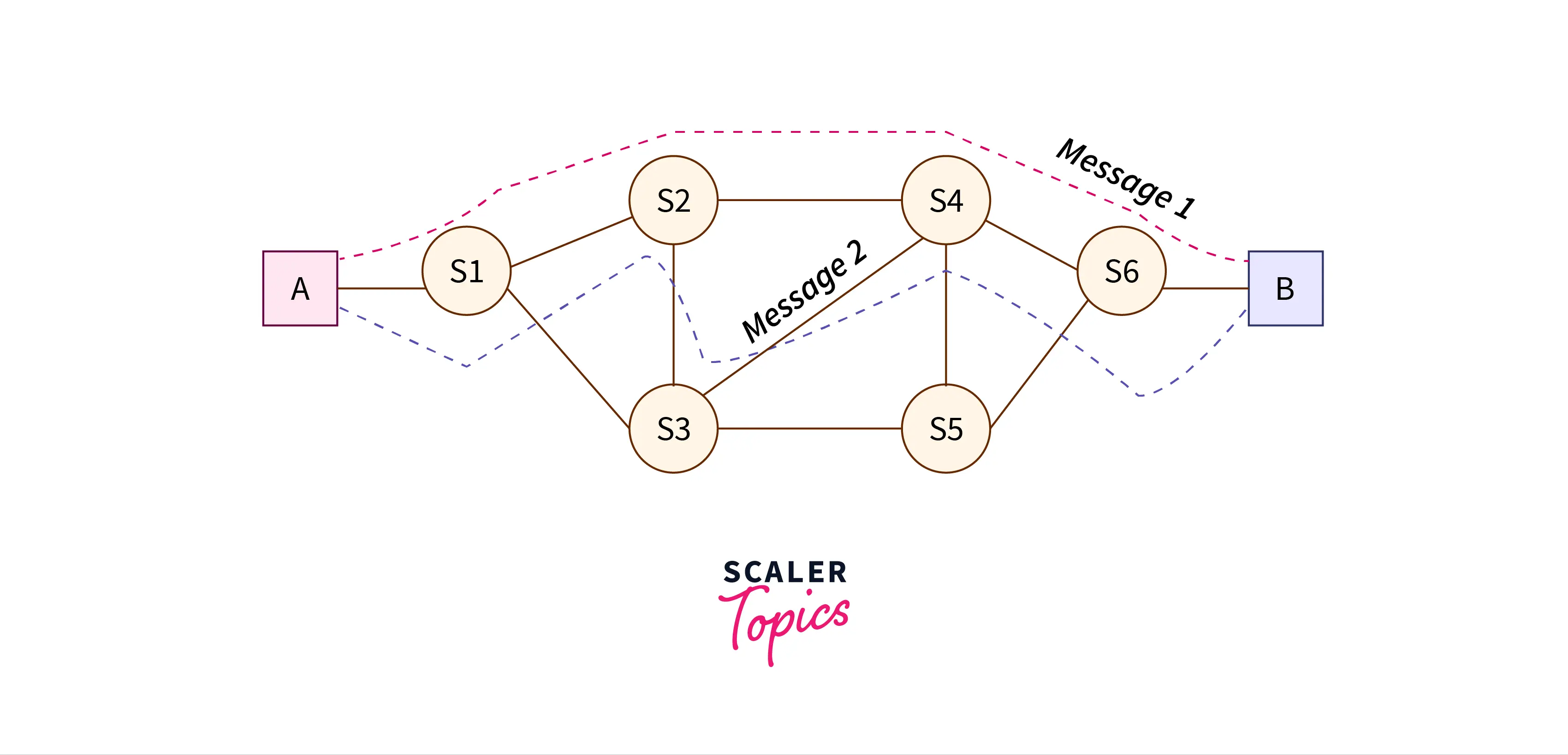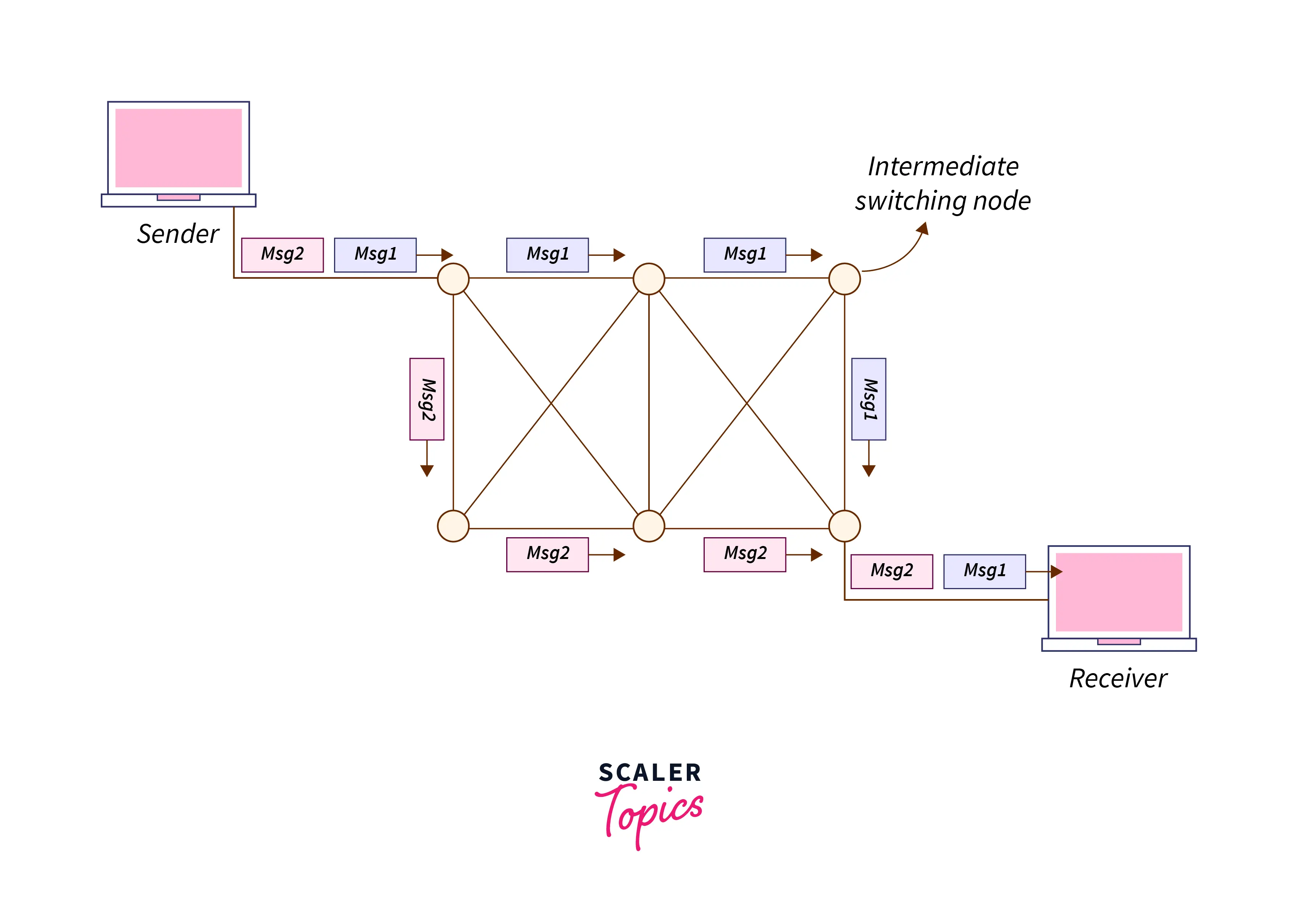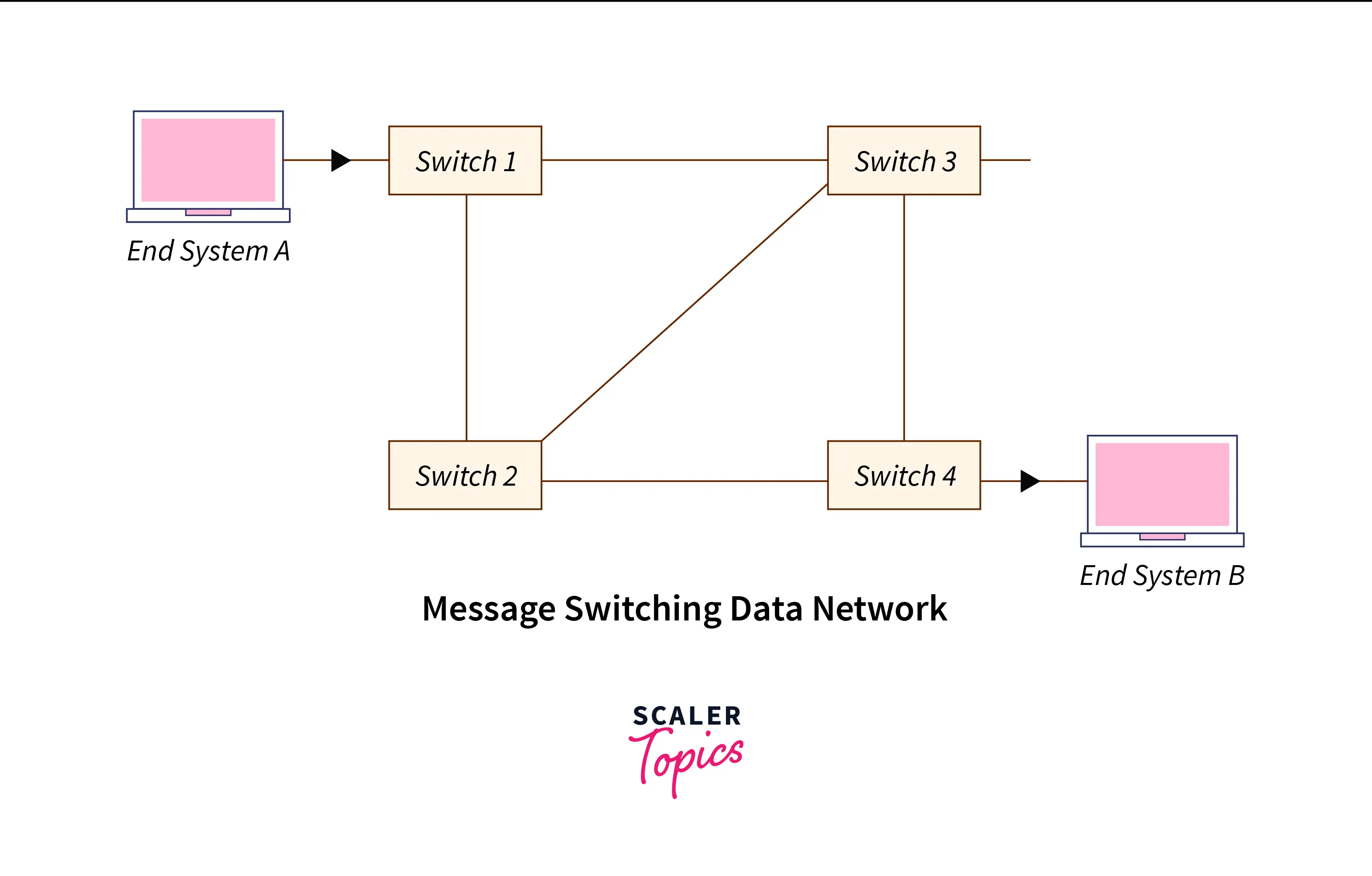Message Switching in Computer Networks
Overview
Message Switching is a connectionless network switching approach in which the complete message is routed from the sender node to the receiver node one hop at a time. It was a forerunner to packet switching. Message switching served as an adequate replacement for circuit switching before the development of packet switching. The first applications of it were in data transmissions via telex networks and paper tape relay systems. Although packet switching has completely supplanted message switching, ad hoc sensor networks, military networks, and satellite communications networks still use the technique.
Switching Techniques
Switched communication networks convey data from source to destination through numerous intermediate nodes. Switching is a technique by which nodes control data to transmit it between certain places on a network. There may be several paths from source to receiver in massive networks. The switching technique will determine the appropriate data transmission path. The three common switching techniques are:

Circuit Switching
Circuit Switching is a method of switching that establishes a dedicated path between the transmitter and the receiver. The dedicated path will exist until the connection is terminated once the connection is made using the Circuit Switching Technique.
Before any communication can take place, there must be a complete end-to-end path in the circuit switch network. When a user wants to send data, audio, or video, a request signal is sent to the receiver, and the receiver responds with an acknowledgment to ensure that the dedicated path is available. After receiving acknowledgment, the data is sent along a predefined path. Previously circuit switching was used in public telephone networks for voice transmission, but in the current scenario, it is replaced by virtual circuits.
Packet Switching
Packet Switching is a switching mechanism that divides a message into smaller bits and sends them separately rather than all at once. The message is divided into smaller bits called packets, and each packet is given a unique number to identify its order at the receiving end. Each packet's header includes the source address, destination address, and sequence number. Packets will travel the shortest path possible throughout the network before being reassembled in the correct order at the receiving end.
There are two approaches used in packet switching:
- Datagram Packet switching:- It is a packet switching technique in which each packet, known as a datagram, is treated as a separate entity. Each packet carries destination information, which the switch uses to route the packet to the correct destination.
- Virtual Circuit Switching:- It is also known as connection-oriented switching. Virtual circuit switching establishes a predetermined path before messages are sent. The connection between the sender and the receiver is established using the call request and call accept packets.
Message Switching
Message Switching is a switching method that transmits a complete message and routes it through intermediary nodes where it is stored and transmitted. The Message Switching technique has no defined path between the sender and the recipient. The message includes the destination address. Because the message is routed through the intermediary nodes based on the information contained in the message, Message Switching enables dynamic routing.
Before sending the message to the next node, each node stores the entire message. This is known as a store and forward network.
What is Message Switching?
Message Switching is a network switching strategy in which data or message is transmitted entirely from the source to the destination node, one hop at a time. Every intermediary switch in the network stores the entire message during message routing.
If all of the network's resources are used up, or the network becomes blocked, the message-switched network stores and delays the message until sufficient resources are available for effective transmission. Message switching served as an adequate replacement for circuit switching before the development of packet switching. The first applications of it were in data transmissions via telex networks and paper tape relay systems. Although packet switching has completely supplanted message switching, ad hoc sensor networks, military networks, and satellite communications networks still use the technique.
The source node and destination nodes are not directly coupled in message switching. Instead, intermediary nodes (mostly switches) are in charge of transmitting messages from one node to the next. As a result, every intermediary node in the network must retain each message before retransmitting them one at a time as appropriate resources become available. Messages are retained indefinitely if the resources are not available. This process is referred to as store and forward. Every message should include a header, which generally contains routing information such as the source and destination, expiry time, priority level, and so on.
Each switching node in a message switching network must have enough storage to buffer messages because message switching treats each message as a single complete entity. So if the message size exceeds the storage capacity of the switch, then the message is strictly discarded. This is one of the significant disadvantages of using these switching methods.
The figure below explains how messages are transferred from sender to receiver in the Message Switching networks.

In the figure Message 1 follows the path A->S1->S2->S4->S6->B, while the Message 2 follows A->S1->S2->S3->S4->S6->B. This is due to the fact Message switching uses dynamic routing.
History of Message Switching
In the 1950s, Western Union used a message switching system called Plan 55-A to process telegrams. In 1962, Leonard Kleinrock completed a Ph.D. thesis at the Massachusetts Institute of Technology that investigated queueing delays in this system. Collins Radio Company of Newport Beach, California, developed message switching between 1959 and 1963 for sale to commercial airlines, banks, and railroads.
Wesley Clark's plan to build a message switching network employing interface message processors in April 1967 served as the basis for the first design of the ARPANET. Following the first ACM Symposium on Operating Systems Principles in October 1967, Larry Roberts added packet switching to the design. He did so by drawing inspiration from Donald Davies' and Paul Baran's work on the topic.
Nowadays, message switching systems are generally implemented over packet-switched or circuit-switched data networks. For example, In most electronic mail systems, the delivery mechanism is based on message switching, whereas the network is circuit-switched or packet-switched. Each message in message switching network is treated independently.
Each message contains addressing information, which is read at each switch and used to determine the transfer path to the next switch. Various messages may not be transferred over the same path, depending on network conditions. Each message is stored (typically on a hard drive owing to RAM limits) before being transmitted to the next switch. As a result, it is often known as a "store and forward" network.
The most popular application for message switching is email. Email delivery can be delayed, unlike real-time data transfer between two computers, which is not permitted.
Process of Message Switching
Message switching treats each message as a separate entity. The sender node adds the destination address to the message before sending the message. Then the message is completely delivered to the next intermediate switching node. The intermediate node stores the complete message, checks for transmission errors, validate the destination address, and then forwards it to the next node. This process is repeated until the message reaches its destination.
If the needed outgoing circuit is busy, the incoming message is not discarded by the switching node. Instead, it is queued for that route and retransmitted when the required route becomes available. This is referred to as a store and forward network.
The diagram given below illustrates the complete process of Message Switching.

Characteristics of Message Switching
Message Switching Provides two essential and distinct characteristics.
Store and Forward
In a Message Switching network, the sender and receiver are physically not connected to each other. As a result, intermediate nodes between sender and receiver are primarily in charge of forwarding the message to the next node in the network.
Thus, intermediate nodes must have the storage capacity to transfer the message because any message will only be transferred if the next node and the link between them are accessible to connect; otherwise, this message will be retained indefinitely.
A store-and-forward switch will thus forward a message only if adequate resources are available and the following node is ready to accept the data. The procedure is repeated until the data is transferred to the destination node. As a result, it is known as the store-and-forward property. Previously, the store-and-forward property was used in telegraph message switching facilities.
Message Delivery
This implies encapsulating the complete information in a single message and sending it from the source to the destination node. Each message must have a header with message routing information, such as the source and destination.
Delay in Message Switching
- A message switched network comprises store-and-forward switches linked together by trunks. A single trunk is usually enough to connect two switches.
- We can provide multiple trunks to boost reliability. Every switch has a storage unit where all incoming messages are momentarily held before being transmitted to another switch.
A network trunk is a communications link or link that is designed to transport multiple signals at the same time to offer network access between two points.

- The store-and-forward service operates similarly to the telegram service. A message is forwarded from switch to switch with the destination address till it reaches the destination.
- As illustrated in Fig, assume that end system A wishes to transmit a message to end system B. A sends its message to entry switch 1 coupled with the destination's and its own addresses. The addresses are contained in the message's header.
- The message is accepted by Switch 1, and the destination address is examined. Each node maintains its routing table. This routing table contains entries representing destination nodes and the switch's corresponding outgoing trunks. Every trunk has its queue.
- As we can reach the destination node via multiple routes, the decision to send the message to a specific next switch is based on the expected delay in its queue. Assume the message from A is queued for node 2.
- The message received at switch 2 is added to a queue of messages waiting to be transmitted to switch 4. When its turn comes, the message is routed to switch 4, which forwards it to the intended recipient.
- Some of the fundamental characteristics of store-and-forward message switching, which are the main reasons for delay in message switching networks, are as follows:
- The store-and-forward service is unidirectional. The network does not send confirmation to the source after the message is delivered. Suppose end system B is required to send an acknowledgment to the message received from A. In that case, the network treats the acknowledgment like any other message and includes the destination and source addresses.
- The network may use an error control mechanism for message transfer from switch to switch. The message may be appended with error-checking bits, and if an error is detected, the receiving switch may request the retransmission of the message from the sending switch. As a result, the sending switch must retain a copy of the message until an acknowledgment is received.
- As the message is buffered at the switch at each transmission stage, each switch-to-switch transfer is a separate operation. The trunks can operate at a variety of data rates. The end systems at the source and destination can operate at different data rates.
- The network treats each message as a distinct entity in message switching; therefore, each message's destination and source addresses are repeated.
- Delay in delivery. The time diagram for routing a message through a message switching network is shown in Figure. The message travels through the entry switch, two transit switches, and ultimately the exit switch to reach its destination.

So the total time in message delivery is calculated by the sum of the following components:
- The Switch delay.
- Switch To switch propagation delay.
- Message Transmission Time.
Advantages of Message Switching
- Message switching reduces network traffic congestion because it can store messages for which no communication channel is available.
- Message broadcasting takes far less bandwidth than circuit switching.
- Unlike circuit switching, it does not require the physical connection of source and destination devices.
- It is possible to include priority in the messages because they are transmitted using a store and forward approach.
- We can alter the size of the message sent across the network. As a result, it handles any amount of data.
- Data channels are shared across connected devices, improving the available bandwidth's efficiency.
- Message switching systems can send a single message to several destinations; however, this capability is not available in circuit switching.
Disadvantages of Message Switching
- Since message length is unbounded, each switching node must have enough storage to buffer messages.
- Message switching cannot be employed for real-time applications since storing messages adds time to the process.
- The message switching method does not establish a dedicated path between the devices. There is no direct relationship between the sender node and the receiver node, hence communication is not reliable.
- Message-switched networks are highly sluggish since processing occurs in every node, resulting in poor performance.
- People are generally unaware of whether messages are correctly sent since the system is so complex. This could lead to difficulties in social relationships.
Applications of Message Switching
In telegraph message switching centers, the store-and-forward approach was used. Although many essential networks and systems today are packet-switched or circuit-switched networks, their delivery mechanisms might be message-based. For instance, In most electronic mail systems, the delivery mechanism is based on message switching, whereas the network is circuit-switched or packet-switched.
Conclusion
- There may be several paths from source to receiver in massive networks. The switching technique will determine the appropriate data transmission path. The three common switching techniques are:
- Circuit Switching
- Message Switching
- Packet Switching
- The Collins Radio Company of Newport Beach, California, developed message switching between 1959 and 1963 for sale to commercial airlines, banks, and railroads.
- Message Switching is a connectionless network switching approach in which the complete message is routed from the sender node to the receiver node one hop at a time.
- Message Switching provides two essential and distinct characteristics.
- Store and Fordward:- If all of the network's resources are used up, or the network becomes blocked, the message-switched network stores and delays the message until sufficient resources are available for effective transmission.
- Message Delivery:- This implies encapsulating the complete information in a single message and sending it from the source to the destination node.
- The total time in message delivery is calculated by the sum of the following components:
- The Switch delay.
- Switch To switch propagation delay.
- Message Transmission Time.
